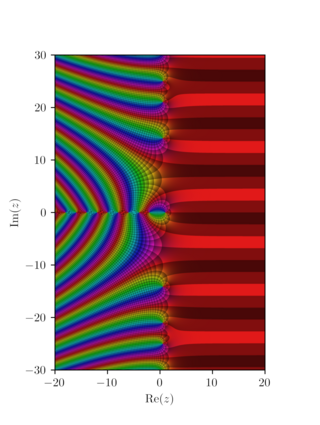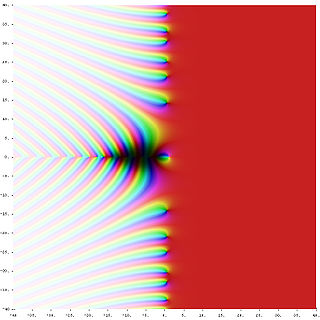The Riemann hypothesis is one of the most important conjectures in mathematics. It is a statement about the zeros of the Riemann zeta function. Various geometrical and arithmetical objects can be described by so-called global L-functions, which are formally similar to the Riemann zeta-function. One can then ask the same question about the zeros of these L-functions, yielding various generalizations of the Riemann hypothesis. Many mathematicians believe these generalizations of the Riemann hypothesis to be true. The only cases of these conjectures which have been proven occur in the algebraic function field case.
In representation theory and algebraic number theory, the Langlands program is a web of far-reaching and influential conjectures about connections between number theory and geometry. Proposed by Robert Langlands, it seeks to relate Galois groups in algebraic number theory to automorphic forms and representation theory of algebraic groups over local fields and adeles. Widely seen as the single biggest project in modern mathematical research, the Langlands program has been described by Edward Frenkel as "a kind of grand unified theory of mathematics."
In mathematics, the Weil conjectures were highly influential proposals by André Weil (1949). They led to a successful multi-decade program to prove them, in which many leading researchers developed the framework of modern algebraic geometry and number theory.

In mathematics, an L-function is a meromorphic function on the complex plane, associated to one out of several categories of mathematical objects. An L-series is a Dirichlet series, usually convergent on a half-plane, that may give rise to an L-function via analytic continuation. The Riemann zeta function is an example of an L-function, and one important conjecture involving L-functions is the Riemann hypothesis and its generalization.

In mathematics, analytic number theory is a branch of number theory that uses methods from mathematical analysis to solve problems about the integers. It is often said to have begun with Peter Gustav Lejeune Dirichlet's 1837 introduction of Dirichlet L-functions to give the first proof of Dirichlet's theorem on arithmetic progressions. It is well known for its results on prime numbers and additive number theory.

Pierre René, Viscount Deligne is a Belgian mathematician. He is best known for work on the Weil conjectures, leading to a complete proof in 1973. He is the winner of the 2013 Abel Prize, 2008 Wolf Prize, 1988 Crafoord Prize, and 1978 Fields Medal.
In mathematics, a Dirichlet L-series is a function of the form
In mathematics, the Ramanujan conjecture, due to Srinivasa Ramanujan (1916, p. 176), states that Ramanujan's tau function given by the Fourier coefficients τ(n) of the cusp form Δ(z) of weight 12
In mathematics, the Dedekind zeta function of an algebraic number field K, generally denoted ζK(s), is a generalization of the Riemann zeta function (which is obtained in the case where K is the field of rational numbers Q). It can be defined as a Dirichlet series, it has an Euler product expansion, it satisfies a functional equation, it has an analytic continuation to a meromorphic function on the complex plane C with only a simple pole at s = 1, and its values encode arithmetic data of K. The extended Riemann hypothesis states that if ζK(s) = 0 and 0 < Re(s) < 1, then Re(s) = 1/2.
In number theory, Artin's conjecture on primitive roots states that a given integer a that is neither a square number nor −1 is a primitive root modulo infinitely many primes p. The conjecture also ascribes an asymptotic density to these primes. This conjectural density equals Artin's constant or a rational multiple thereof.
In mathematics, the Selberg class is an axiomatic definition of a class of L-functions. The members of the class are Dirichlet series which obey four axioms that seem to capture the essential properties satisfied by most functions that are commonly called L-functions or zeta functions. Although the exact nature of the class is conjectural, the hope is that the definition of the class will lead to a classification of its contents and an elucidation of its properties, including insight into their relationship to automorphic forms and the Riemann hypothesis. The class was defined by Atle Selberg in, who preferred not to use the word "axiom" that later authors have employed.
In mathematics, the explicit formulae for L-functions are relations between sums over the complex number zeroes of an L-function and sums over prime powers, introduced by Riemann (1859) for the Riemann zeta function. Such explicit formulae have been applied also to questions on bounding the discriminant of an algebraic number field, and the conductor of a number field.
In mathematics, an Artin L-function is a type of Dirichlet series associated to a linear representation ρ of a Galois group G. These functions were introduced in 1923 by Emil Artin, in connection with his research into class field theory. Their fundamental properties, in particular the Artin conjecture described below, have turned out to be resistant to easy proof. One of the aims of proposed non-abelian class field theory is to incorporate the complex-analytic nature of Artin L-functions into a larger framework, such as is provided by automorphic forms and the Langlands program. So far, only a small part of such a theory has been put on a firm basis.
This is a glossary of arithmetic and diophantine geometry in mathematics, areas growing out of the traditional study of Diophantine equations to encompass large parts of number theory and algebraic geometry. Much of the theory is in the form of proposed conjectures, which can be related at various levels of generality.

In mathematics, the Riemann hypothesis is the conjecture that the Riemann zeta function has its zeros only at the negative even integers and complex numbers with real part 1/2. Many consider it to be the most important unsolved problem in pure mathematics. It is of great interest in number theory because it implies results about the distribution of prime numbers. It was proposed by Bernhard Riemann (1859), after whom it is named.
In mathematics, a p-adic zeta function, or more generally a p-adic L-function, is a function analogous to the Riemann zeta function, or more general L-functions, but whose domain and target are p-adic. For example, the domain could be the p-adic integersZp, a profinite p-group, or a p-adic family of Galois representations, and the image could be the p-adic numbersQp or its algebraic closure.
In mathematics, motivic L-functions are a generalization of Hasse–Weil L-functions to general motives over global fields. The local L-factor at a finite place v is similarly given by the characteristic polynomial of a Frobenius element at v acting on the v-inertial invariants of the v-adic realization of the motive. For infinite places, Jean-Pierre Serre gave a recipe in (Serre 1970) for the so-called Gamma factors in terms of the Hodge realization of the motive. It is conjectured that, like other L-functions, that each motivic L-function can be analytically continued to a meromorphic function on the entire complex plane and satisfies a functional equation relating the L-function L(s, M) of a motive M to L(1 − s, M∨), where M∨ is the dual of the motive M.

Christopher Deninger is a German mathematician at the University of Münster. Deninger's research focuses on arithmetic geometry, including applications to L-functions.
In mathematics, the arithmetic zeta function is a zeta function associated with a scheme of finite type over integers. The arithmetic zeta function generalizes the Riemann zeta function and Dedekind zeta function to higher dimensions. The arithmetic zeta function is one of the most-fundamental objects of number theory.





